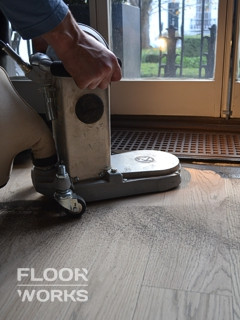Oil finishes - the different types and way of application
This article is dedicated to the various types of oil finishes, their properties, their strengths and weaknesses and their possible applications.

What are oil-based finishes?
If you have no previous experience with floor finishing products, finding the right one for you can be quite a difficult task. Even the names are confusing. Have you ever seen the terms oil finish, oil-based finish, penetrating oil finish and wondered if they are the same thing or something completely different?
Oil finishes are linseed, tung, teak, danish, hard wax and oil-based polyurethane lacquers.
They are absorbed into the wood, hardening it and providing both strong internal and relatively weak external protection. Lacquers and varnishes form a coating around the wood. Effectively they sit on top of it without soaking in.
As the name implies, oil-based polyurethane lacquers are based on oils (often contain 40 to 60 percent oil) but isn’t a penetrating finish! Because of this, we won’t be discussing it in this article.
While oils are less resilient compared to lacquers, they can be incredibly effective when applied on some exotic trees like teak, cocobolo, ebony and rosewood which have a high concentration of natural oils. Any oil finish applied on top of such type of wood has enhanced properties. If you value the unique advantages of this type of finishes, combining them with a naturally oily exotic woods will be a great idea.
Why use an oil finish?
Natural look. Oils soak into the wood. They enhance its grain and bring out its natural beauty. Compared to it, a lacquered floor looks like covered in a shiny plastic. Oils simply provide a more aesthetically pleasing appearance that surface finishes cannot match.
Easy to repair. If your surface finish takes a more noticeable form of damage you have to sand, or at least buff it, in order to keep a pristine appearance. A quality oil finish can be re-coated over and over without the need for sanding.
Low VOC. Volatile Organic Compounds (VOCs) are toxic substances often found in many flooring adhesives and finishes. Oil-based polyurethane contains one the highest allowed concentrations of those chemicals. Some of them can emit off-gasses for years after installation which are rumoured to lead to various health problems.
With few exceptions, most finishes today do contain some VOCs. However, the amount of toxicity varies greatly depending on the product. There are completely natural products with zero amount of VOC. Most modern oils probably will contain an extremely low amount of chemicals but nowhere near as much as an oil-based poly.
More on oil finishes
Linseed and boiled linseed oil. It is extracted from the flax seed and used for the preservation of both wood and concrete. Linseed oil, like most modern finishes, tends to go yellow over time. This makes it more suitable for darker types of wood like mahogany. Dries very, very slowly.
“Boiled” linseed is not truly boiled despite the name. It is just the addition of solvents to decrease the exponentially high drying time and provide somewhat deeper colour. The downside is that normal linseed is more durable.
Unfortunately, neither type of linseed has good enough properties to make them competitive to most modern alternatives. The only two redeeming qualities are the incredibly cheap prices and the fact it is a completely natural product.
Tung oil. It’s a natural product, first used by the Chinese for hundreds if not thousands of years. It is more durable than any other oil but not suitable for commercial use because of its incredibly long production time. This is, without a contest, the best type for wood flooring but still cannot compare to polyurethane.
Danish / Teak oil. It is a combination of tung and linseed with added urethane. In many ways, it is similar to a varnish. Not as durable as the polyurethane or tung and not as cheap as the linseed oil. Some would say it the perfect middle ground. Thankfully, dries faster than linseed and is more resilient.
Hard wax oil. Contrary to the popular opinion, they are not that durable. Hard waxes can soak into the wood but the protective film on top is still weak compared to most varnishes. The ease of application makes it possible even for an unskilled person to apply but they are not superior to more “traditional” products like teak oils.



